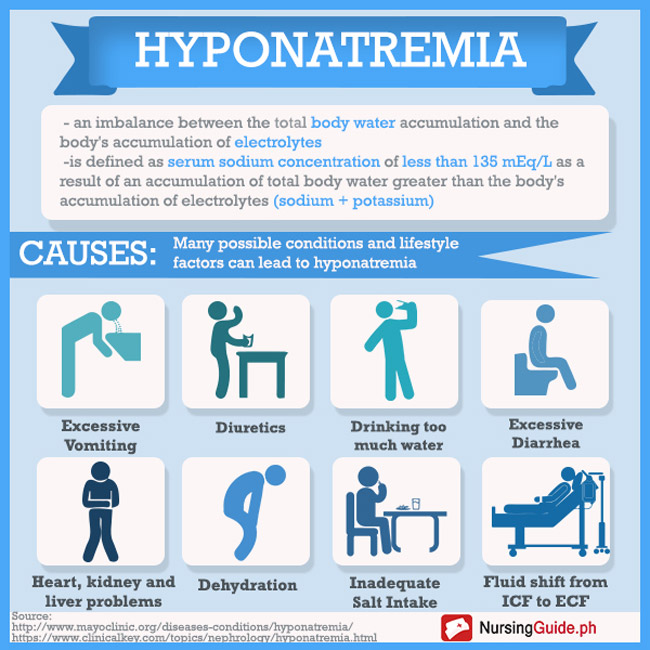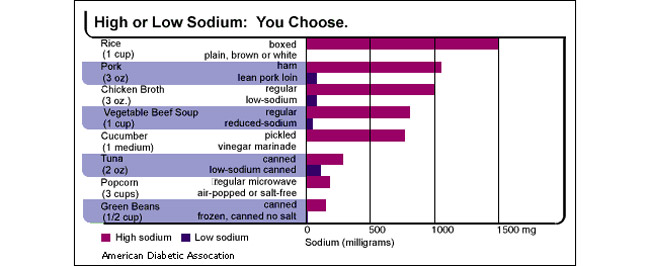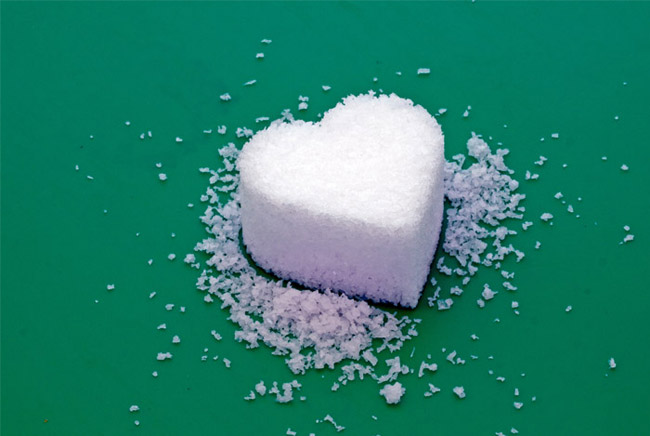Hyponatremia: Low blood sodium: Symptoms, Diagnosis and Treatment

Hyponatremia is low sodium concentration in the blood. Normal
serum sodium levels are between approximately 135 and 145 mEq/liter
(135 - 145 mmol/L). Hyponatremia is generally defined as a serum
sodium level of less than 135 mEq/L and is considered severe when
the serum sodium level is below 125 mEq/L.
Too little sodium in the diet alone is very rarely the cause of
hyponatremia, although it can promote hyponatremia indirectly and
has been associated with MDMA-induced hyponatremia. Sodium loss can
lead to a state of low blood volume, which signals the release of
anti-diuretic hormone (ADH). ADH release leads to water retention
and dilution of the blood resulting in a low sodium concentration.
Many conditions including congestive heart failure, liver failure,
kidney failure and pneumonia are commonly associated with a low
sodium concentration in the blood. This state can also be caused by
overhydration from drinking too much water because of excess thirst
(polydipsia). Exercise-associated hyponatremia (EAH) is common in
marathon runners and participants of other endurance events. 13% of
the athletes who finished the 2002 Boston Marathon were in a
hyponatremic state, that is, the salt levels in their blood had
fallen below usual levels.
Sodium is the primary positively charged ion in the environment
outside of the cell and cannot freely cross from the interstitial
space into the cell. Charged sodium ions attract up to 25 water
molecules around them thereby creating a large polar structure that
is too large to pass through the cell membrane.
Signs and symptoms of hyponatremia include nausea and vomiting,
headache, short-term memory loss, confusion, lethargy, fatigue, loss
of appetite, irritability, muscle weakness, spasms or cramps,
seizures, and decreased consciousness or coma. The presence and
severity of signs and symptoms are related to the level of salt in
the blood, with lower levels of plasma sodium associated with more
severe symptoms. However, emerging data suggest that mild
hyponatremia (plasma sodium levels at 131 mEq/L or above) is
associated with numerous complications or subtle, presently
unrecognized symptoms.

Hyponatremia facts
- Hyponatremia refers to a low level of sodium in the blood.
- Hyponatremia may result from excess fluid in the body relative to a normal amount of sodium, or it may be due to a loss of sodium and body fluid.
- Symptoms are nonspecific and can include mental changes, headache, nausea and vomiting, tiredness, muscle spasms, and seizures.
- Severe hyponatremia can lead to coma and can be fatal.
- Treatment of hyponatremia involves intravenous fluid and electrolyte replacement, medications to manage the symptoms of hyponatremia, as well as any treatments for the underlying cause.
What is hyponatremia (low blood sodium)
Hyponatremia refers to a lower-than-normal level of sodium in
the blood. Sodium is essential for many body functions including
the maintenance of fluid balance, regulation of blood pressure,
and normal function of the nervous system. Hyponatremia has
sometimes been referred to as "water intoxication," especially
when it is due to the consumption of excess water, for example
during strenuous exercise, without adequate replacement of
sodium.
Sodium is the major positively charged ion (cation) in the fluid
outside of cells of the body. The chemical notation for sodium is
Na. When combined with chloride (Cl), the resulting substance is
table salt (NaCl).
The normal blood sodium level is 135 - 145 milliEquivalents/liter (mEq/L),
or in international units, 135 - 145 millimoles/liter (mmol/L).
Results may vary slightly among different laboratories.

What causes hyponatremia (low blood sodium)
A low sodium level in the blood may result from excess water or
fluid in the body, diluting the normal amount of sodium so that the
concentration appears low. This type of hyponatremia can be the
result of chronic conditions such as kidney failure (when excess
fluid cannot be efficiently excreted) and congestive heart failure,
in which excess fluid accumulates in the body. SIADH (syndrome of
inappropriate anti-diuretic hormone) is a disease whereby the body
produces too much anti-diuretic hormone (ADH), resulting in
retention of water in the body. Consuming excess water, for example
during strenuous exercise, without adequate replacement of sodium,
can also result in hyponatremia.
Hyponatremia can also result when sodium is lost from the body or
when both sodium and fluid are lost from the body, for example,
during prolonged sweating and severe vomiting or diarrhea.
Medical conditions that can sometimes be associated with
hyponatremia are adrenal insufficiency, hypothyroidism, and
cirrhosis of the liver.
Finally, a number of medications can lower blood sodium levels.
Examples of these include diuretics, vasopressin, and the
sulfonylurea drugs.
Some of the many specific causes of hyponatremia can be listed as
follows:
Hypervolemic hyponatremia -Both sodium & water content increase:
Increase in sodium content leads to hypervolemia and water content
to hyponatremia. Total body water and sodium are regulated
independently.
cirrhosis of the liver
congestive heart failure
nephrotic syndrome in the kidneys
massive edema of any cause
Euvolemic hyponatremia - there is volume expansion in the body, no edema, but hyponatremia occurs

states of severe pain or nausea
in the setting of trauma or other damage to the brain
SIADH (and its many causes)
Hypothyroidism
Glucocorticoid (steroid) deficiency
Hypovolemic hyponatremia - The hypovolemia (extracellular volume
loss) is due to total body sodium loss. The hyponatremia is caused
by a relatively smaller loss in total body water.
any cause of hypovolemia such as prolonged vomiting, decreased oral
intake, severe diarrhea
diuretic use (due to the diuretic causing a volume depleted state
and thence ADH release, and not a direct result of diuretic-induced
urine sodium loss)
Addison's disease and congenital adrenal hyperplasia in which the
adrenal glands do not produce enough steroid hormones (combined
glucocorticoid and mineralocorticoid deficiency)
Miscellaneous causes of hyponatremia that are not included under the
above classification scheme include the following:
factitious hyponatremia (due to massive increases in blood
triglyceride levels, extreme elevation of immunoglobulins as may
occur in multiple myeloma, and very high level of blood glucose)
Hypothyroidism and adrenal insufficiency (both thyroid hormone and
cortisol are required to excrete free water)
Beer potomania and other malnourished states where poor dietary
protein intake leads to inadequate urine solute formation thereby
impeding the kidney's ability to excrete free water
Primary polydipsia (where the amount of urine solute required to
excrete huge quantities of ingested water exceeds the body's ability
to produce it; this typically occurs when 12 or more liters of water
are ingested per day)
A prolonged period of exercise may be a cause.
Symptoms of hyponatremia (low blood sodium)
When sodium levels in the body are low, water tends to enter cells,
causing them to swell. When this occurs in the brain, it is referred
to as cerebral edema. Cerebral edema is particularly dangerous
because the brain is confined in the skull without room for
expansion, and the swelling can lead to brain damage as the pressure
increases within the skull. Cerebral edema occurs only in severe
cases of hyponatremia.
In chronic hyponatremia, in which the blood sodium levels drop
gradually over time, symptoms are typically less severe than with
acute hyponatremia (a sudden drop in blood sodium level). Symptoms
can be very nonspecific and can include:
- headache,
- confusion or altered mental state,
- seizures, and
- decreased consciousness which can proceed to coma and death.

Other possible symptoms include:
- restlessness,
- muscle spasms or cramps,
- weakness, and tiredness.
- Nausea and vomiting may accompany any of the symptoms.
Diagnosis
The history, physical exam, and laboratory testing are required to
diagnose and determine the underlying cause of hyponatremia. A blood
test demonstrating a serum sodium less than 135 mEq/L is diagnostic
for hyponatremia. The history and physical exam are necessary to
help determine if the patient is hypovolemic, euvolemic, or
hypervolemic, which has important implications in determining the
underlying cause. An assessment is also made to determine if the
patient is experiencing symptoms from their hyponatremia. These
include assessments of alertness, concentration, and orientation.
Hyponatremia (low blood sodium) Treatment
Mild chronic hyponatremia may not require treatment other than
adjustments in diet, lifestyle, or medications. For severe or acute
hyponatremia, treatment typically involves the intravenous
administration of fluids and electrolytes. In this case medications
are often needed that treat the underlying cause of the hyponatremia
as well as medications to manage the accompanying symptoms.
Above information is only a supplement to a doctor's diagnosis and
treatment. Women Fitness recommends the doctor should be consulted
before any treatment is taken for Hyponatremia, the low blood sodium
condition.
Video
